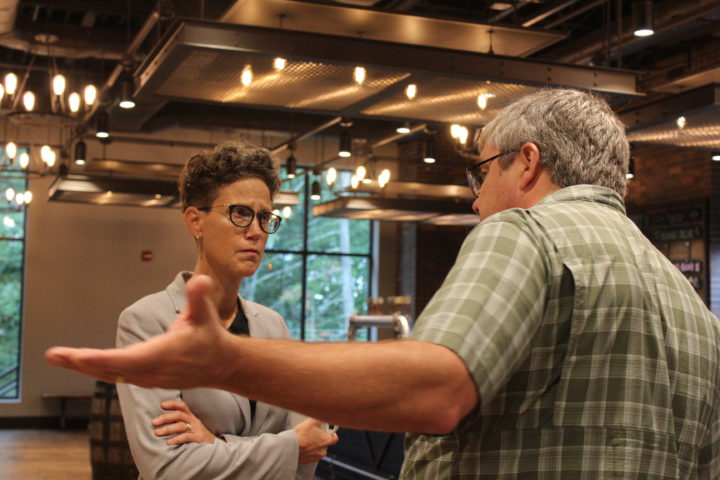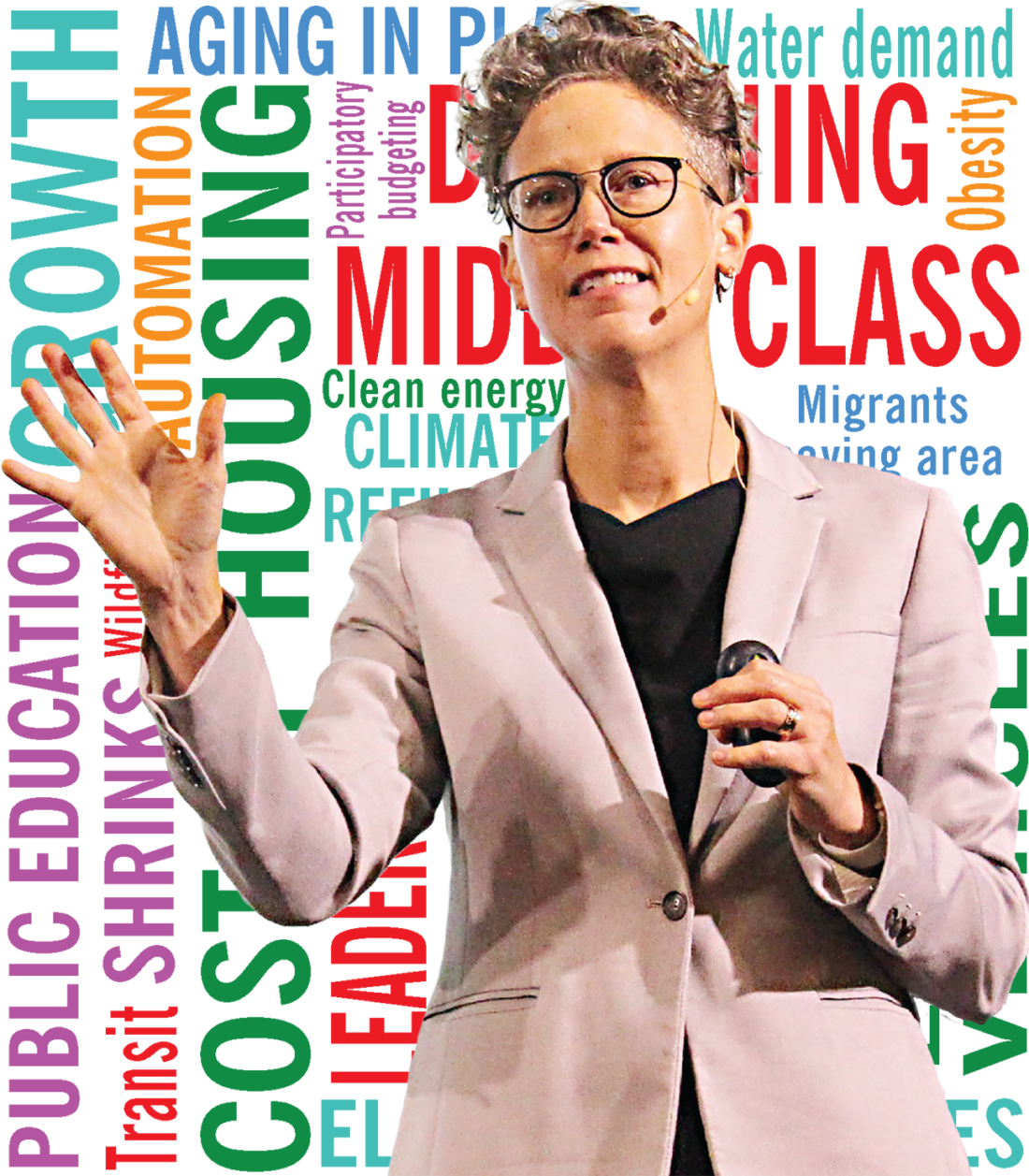Rebecca Ryan isn’t a household name in Buncombe County. And why would she be? A resident of Madison, Wis., and a frequent flyer who consults with organizations and local governments around the country, Ryan spends more of her time powwowing in big-city conference rooms and attending think-tank discussions than she does exploring communities like Leicester, Weaverville or Black Mountain.
But while most Western North Carolina residents wouldn’t know her from Adam, Ryan’s spent the past year and change learning quite a bit about us. Over a series of monthly visits that stretch back to last summer, the consultant has trained her sometimes unnervingly intense gaze on the future of Asheville and Buncombe County. She’s been leading the creation of three important plans — the AVL Greater vision plan, the AVL 5×5 2025 economic development plan and a strategic plan for the Buncombe County Board of Commissioners — during a period of local change she describes as the most profound she’s seen anywhere in her career.
Xpress has followed Ryan’s progress in WNC over the past 16 months. As she wrapped up her work on the AVL Greater and AVL 5×5 2025 plans in late September, we chatted about her upcoming encore keynote address at the Asheville Area Chamber of Commerce’s WomanUP gala on Thursday, Nov. 14, what makes Asheville and Buncombe County different and how we’ll know if the area is on track to make good on the new strategies.
Women rising
After delivering the keynote at last year’s WomanUP celebration, “I thought I was off the hook,” Ryan says. But local event organizers had other ideas, inviting her back for a second appearance this November. While the details of her talk remain under wraps, she teases a couple of the themes she plans to address.
“The suffrage movement is 100 years old this year,” Ryan notes. “It will be a nice opportunity to look back and look ahead.” She will also examine the impact of the anti-sexual assault and women’s empowerment #MeToo and Time’s Up movements, looking at recent examples of social change like same-sex marriage legalization for clues to anticipate potentially lasting shifts in gender dynamics.
Much of Ryan’s practice focuses on work for chambers of commerce, economic development partnerships and local government agencies, so she follows research on municipal governance. She cites a recent study on the financial performance of local governments in five Southwestern states that found that, “In local governments where women are the CEOs, you are far more likely to have a AAA bond rating for the government.”
While acknowledging that former Buncombe County Manager Wanda Greene achieved a AAA bond rating while “raping the county,” Ryan nonetheless posits that financial markets are beginning to consider the gender of top managers in their search for “safe money.”
“If Wall Street can put more money into bond markets where women are leading the municipalities, that is going to do a ton for how we think about [public sector] women CEOs, how we think about women leaders,” she says. Pointing to local female executives like Avril Pinder, Buncombe’s new county manager, and Debra Campbell, Pinder’s counterpart at the city of Asheville, Ryan thinks the area’s gender game is strong.
“I’ve only worked with one other community [Minnetonka, Minn.] where there have been women in so many important positions,” Ryan reveals. While she cautions against focusing too heavily on gender-based stereotypes, she continues, “Generally, women tend to be very collaborative: less competition-oriented and more collaboration-oriented. And for this region, that’s going to be a great thing.”
Winds of change
Considering the number and extent of the organizational transitions the area has seen since she began working here in June 2018, Asheville and Buncombe County need all the advantages they can muster, Ryan says.

“I just feel like you guys have been at the all-you-can-eat buffet for change,” she muses. “It’s hard for me to think about another community that has gone through this much change in the 16 months I’ve been knowing you.”
In addition to new leadership at the city and county (following a police misconduct scandal and a federal corruption investigation, respectively), Ryan cites the acquisition of Mission Health by HCA Healthcare and the subsequent creation of the Dogwood Health Trust as another potential gamechanger.
The hiring of Antony Chiang from Spokane, Wash., to lead the new foundation exemplifies a trend Ryan sees as positive: “The idea that we can hire from outside of the community; we don’t have to make all of our hiring decisions from within.” Campbell’s background managing rapid growth in Charlotte, as well as Pinder’s experience in a community impacted by severe weather associated with climate change, similarly diversify the area’s knowledge base, she notes.
Kit Cramer, president and CEO of the Asheville Area Chamber of Commerce, agrees that the time was right to undertake the planning process.
“None of this is easy,” says Cramer. “It hasn’t been easy and it won’t be easy. But it’s the absolute right thing to do given where we are at this point in our community’s maturation process and given where we are with so many brand-new leaders in key roles.”
There grows the neighborhood
Over the past 16 months, Ryan says she’s had to keep reminding herself that Asheville is still a pretty small town. “We’re like the indie band that struck it big, that had a big hit, and now we’re like, ‘Holy crap. We’re totally in demand, but we don’t have the systems to manage this,’” she explains.
“When you go from the freshman team to the varsity team, you’ve got to play at a whole new level,” continues Ryan, who once played professional basketball in Hungary. She sees her role in part as offering perspectives from places further along the growth trajectory. “Very often there was an opportunity to say, ‘Hey, there is a whole different way of thinking about this,’” she reflects.
At the Sept. 18 rollout of the AVL Greater plan at Sierra Nevada Brewing Co. in Mills River, Ryan said the area’s recent growth will continue. “This level of growth that you are experiencing — basically, adding two additional cities the size of Asheville through 2040 — this amount of growth makes you grow up fast,” she said. “What we’re trying to do with AVL Greater is raise our game, raise our teamwork and figure out how to manage this in the best possible way, because it’s coming. Like it or not, it’s coming.”
Unlike many other fast-growing metro areas, Ryan points out, Asheville faces significant geographic constraints. “I don’t think I’ve ever made a recommendation around land use before, but man, you have got to get that figured out,” she says. “You have very specific places that things can be built — not just houses, but roads as well.”
One exception to the area’s rapid growth is its black population. “This is one of the only communities that I can remember working in recently where your share of African American population is going down, not up,” Ryan says. “You’re an outlier on that.”
While the white population of the Asheville metropolitan area is projected to grow by 89,700 white residents between 2017 and 2037, the black population will only add 500 residents, according to chamber data. Within the boundaries of Buncombe County, “the number and overall share of African Americans is expected to decline by about 440, down to about 14,900, or 5%,” the AVL Greater research trend summary indicates.
Addressing the racially diverse, multigenerational crowd of about 100 movers and shakers at the AVL Greater rollout on Sept. 18, Ryan explained some of her thinking on race, noting that she can only speak from her own perspective as a white person. “Tolerance and inclusion are insufficient. The community we want to create is one where people feel that they belong. Not where they’re tolerated,” she said. “Inclusion is a delusion, in my opinion.”
If present trends continue, Ryan said, “this community will become older, whiter and richer.” To attract young families from diverse backgrounds, she continued, “We’ve got to say this out loud: The quality of your schools is the No. 1 branding issue for young families considering a move here. … If we don’t have a strategy to help our schools overcome the racial equity gaps currently, it doesn’t matter how much we work on the other things. Young families are never going to feel like this is a great place for them.”
Come in threes
Asked whether there are any disadvantages to having one consultant lead three different major planning processes in the same area, Ryan laughs and says she doesn’t have an answer. “This is my first time doing this level of work in a community,” she explains. “There may be downsides; we’ll find out.” Still, she says, “In this case, it’s been the right thing to do.”

Ryan says she connected with the chamber’s Cramer through another business contact. The outline of a planning project evolved through multiple conversations — “We dated for a while,” jokes Ryan — before a deal was struck. Later, that engagement was expanded to include support for the AVL 5×5 2025 economic development plan.
Completing the two planning processes in tandem, Cramer says, helped uncover connections between social issues like affordable housing and more traditional business concerns. Those linkages are often overlooked, but she believes taking a more holistic view makes good business sense. “We’ve asked for opportunities before the public bodies to speak … so that we can help drive better understanding of the entire picture of the economy, what we bring to it, where we all need to be working together and why,” she explains.
According to Pinder, Buncombe County’s new manager, her organization’s interest in Ryan grew out of the consultant’s work with the chamber. “County staff worked with Rebecca Ryan as participants in the AVL Greater work sessions in September of 2018. Through that work in our community, county staff felt she offered a unique knowledge of current data and trends,” Pinder wrote in an email.
“After a review of Ms. Ryan’s proposed workshop approach, her experience working individually with organizations in the community via AVL Greater and proposed scope of work, the county decided to hire Ms. Ryan in July 2019,” Pinder explained. Ryan’s $40,000 county contract runs through the end of the year.
Of the commissioners, Ryan says, “They have a real desire to turn the page [from the county government corruption scandal] and show that they are moving forward in a strategic way.”
As part of her agreement with the chamber, Ryan also served as “resident futurist” for chamber members interested in picking her brain, according to Cramer. By Ryan’s count, she has met with 13 area organizations, including the Center for Craft and the Asheville Area Arts Council.
Other initiatives
Ryan’s projects aren’t the only important planning processes underway in the area. The Buncombe County Tourism Development Authority’s Tourism Management and Investment Plan and the listening sessions held by Dogwood Health Trust are also critical to the region’s future, she says.
“Increasingly, tourists say, ‘I don’t want to feel like a tourist. I want to feel like a local,’” Ryan observes. If the TDA’s future investments benefit both residents and tourists, “It’s a double win,” she says. “It’s a win for the residents and it’s also going to be an attractor for the visitors.”
At the same time, Ryan points out that the TDA’s planning process is being led by a 125-person tourism and destination planning consultancy, PGAV of St. Louis. Generally speaking, in the tourism industry, “not a lot has changed in how that market thinks and works. It’s about ads and placement and branding and taglines,” she says.
But comments by Marla Tambellini, the convention and visitors bureau’s deputy director, at the AVL Greater rollout gave Ryan hope that “maybe they get it: that making it a great place to live is what the magic is going to be for future tourists, because that’s correct,” she says. Referring to the portion of the hotel occupancy tax used to fund tourism-related projects, she commented, “That amount of money goes a long way in a community like Asheville and Buncombe County.” According to the TDA, $44 million generated by the tax has supported 39 local projects since 2001. That spending represents a quarter of the county’s 6% room tax; the other 75% pays for advertising and marketing the area.
As Dogwood Health Trust welcomes its first leader and sets goals for spending between $60 million and $75 million throughout an 18-county region annually, Ryan says, “I’m really interested to see how they define well-being. Because I know we did good research for AVL 5×5 on the most contemporary definitions of well-being and what the science is telling us about well-being. So I’m anxious to hear how Dogwood defines it and what they decide on as their theory of change.”
Eye on the ball
Ryan will wrap up her work with the Buncombe County Board of Commissioners by the end of the year, at which point she’ll be over and out in the region for now.
“The truth is, we’re really not going to know if this AVL Greater stuff really worked for several years,” she says. Many dominoes must fall to set in motion the expected beneficial effects of the wide-ranging and collaborative approach she has advocated. “And in a distraction economy like we live in, it’s sometimes hard to keep your eye on the ball for very long,” she points out.
“Four years from now, I want to be able to come back to this community and say, ‘How are we doing around leadership? Are we all on the same page? Are we using the triple bottom line as leaders?’” Ryan continues, referencing the philosophy that organizations should be driven in equal parts by economics, environmental impact and social responsibility. “I want to come back and say, ‘Do we have a land use plan?’ These are the things that I want to come back and check in on and see if these have happened in the way that we’ve said are going to be most beneficial for the long-term future.”
But as she pursues her globe-trotting, future-oriented consulting practice around the United States, there’s little chance that WNC will fall off Ryan’s map. Her wife, Lauren Azar, wants to retire here.
“Her mom and her sister live in Brevard,” Ryan says. “She loves Brevard, and Transylvania County is eventually going to get touched by all the growth you guys are experiencing, too. It’s headed that way.”
Editor’s note: This story was updated at 12:12 p.m. on Oct. 13 in the fourth paragraph under the heading “Women rising” to clarify that Ryan was speaking of public sector executives in her quote in that paragraph.




With all of this talk of diversity, acceptance, and inclusion, what is being done to study and reduce ableism and socioeconomic disparity in our community? What about inclusion of those with disabilities and the poor? Aren’t they area’s largest minority groups? What about the Latino, Hispanic population? Do area leaders recruited and selected by local government and public institutions like the school and college systems reflect those groups? Without a doubt, city and county officials should address the needs of its black and white citizens. But there are also other minority groups in the community facing access and equity problems. Diversity is a broad concept. Issues of diversity, inclusion, equity, and access— for all— are not a new fad thing. They should not represent a pick list for feel good, pet projects for mostly white, middle class, able bodied civil servants and citizens focused on the needs of a select group of minorities. Nor should they be used as platform by minority civil servants and citizens to advance the needs of their own minority group without balanced consideration for the needs of all other groups, minority and majority. Nope, no favoritism or tokenism or reverse discrimination or elitism. Much more logical effort at truly fair and equal inclusion of all, please.
That’s good consultancy. Take piles of money from different sources, set goals that come in to play long after you are gone and declare that its going to be years before we really know the impact.
Actually, we all know. Lots of meetings. Group A says B is great. B says C is great. C then endorses A.
Just a giant load of consultant bs. Strategic planning replaced with strategic foresight? Yep, that sleight of hand is really going to be a great seller of more services.
These are not the droids you are looking for.